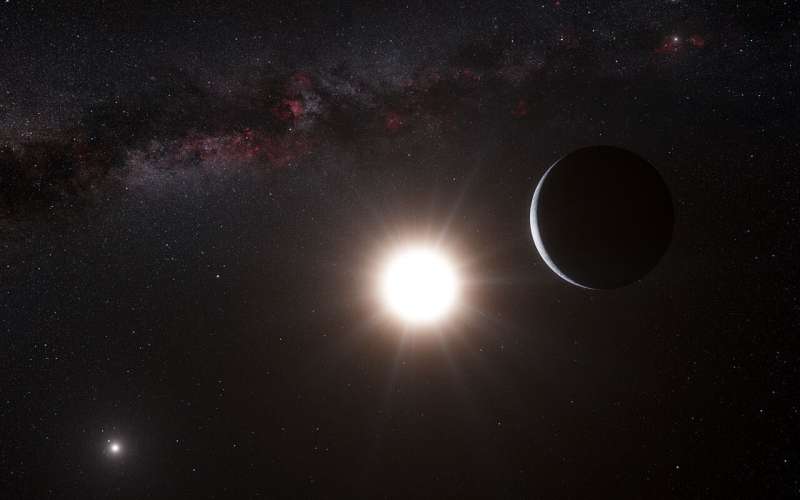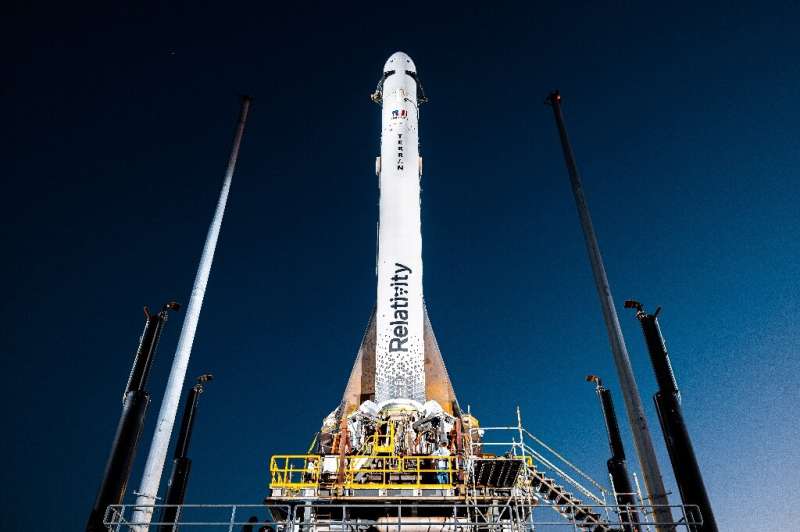
Copernical Team
NASA seeks student solutions for managing Moon landing dust cloud
 Huntsville AL (SPX) Mar 23, 2023
As NASA and industry partners develop new human landing systems to transport astronauts from lunar orbit to the Moon's surface and back as part of Artemis, the agency is asking university students to investigate solutions to one particularly dusty aspect of landing spacecraft on the lunar surface.
NASA's new Human Lander Challenge invites college students
Huntsville AL (SPX) Mar 23, 2023
As NASA and industry partners develop new human landing systems to transport astronauts from lunar orbit to the Moon's surface and back as part of Artemis, the agency is asking university students to investigate solutions to one particularly dusty aspect of landing spacecraft on the lunar surface.
NASA's new Human Lander Challenge invites college students NRO awards contracts to BlackSky and Planet Labs for hyperspectral capabilities
 The National Reconnaissance Office (NRO) has awarded contracts to BlackSky Technology and Planet Labs Federal for the exploration of commercial hyperspectral image capabilities under the Strategic Commercial Enhancements (SCE) Broad Agency Announcement (BAA) program.
BlackSky Technology, a geospatial intelligence solutions provider, has been selected for a multi-stage SCE BAA framework stu
The National Reconnaissance Office (NRO) has awarded contracts to BlackSky Technology and Planet Labs Federal for the exploration of commercial hyperspectral image capabilities under the Strategic Commercial Enhancements (SCE) Broad Agency Announcement (BAA) program.
BlackSky Technology, a geospatial intelligence solutions provider, has been selected for a multi-stage SCE BAA framework stu Surprisingly simple explanation for the alien comet 'Oumuamua's weird orbit
 In 2017, a mysterious comet dubbed 'Oumuamua fired the imaginations of scientists and the public alike. It was the first known visitor from outside our solar system, it had no bright coma or dust tail, like most comets, and a peculiar shape - something between a cigar and a pancake - and its small size more befitted an asteroid than a comet.
But the fact that it was accelerating away from
In 2017, a mysterious comet dubbed 'Oumuamua fired the imaginations of scientists and the public alike. It was the first known visitor from outside our solar system, it had no bright coma or dust tail, like most comets, and a peculiar shape - something between a cigar and a pancake - and its small size more befitted an asteroid than a comet.
But the fact that it was accelerating away from First results from ESO telescopes on the aftermath of DART's asteroid impact
 Using ESO's Very Large Telescope (VLT), two teams of astronomers have observed the aftermath of the collision between NASA's Double Asteroid Redirection Test (DART) spacecraft and the asteroid Dimorphos. The controlled impact was a test of planetary defence, but also gave astronomers a unique opportunity to learn more about the asteroid's composition from the expelled material.
On 26 Septe
Using ESO's Very Large Telescope (VLT), two teams of astronomers have observed the aftermath of the collision between NASA's Double Asteroid Redirection Test (DART) spacecraft and the asteroid Dimorphos. The controlled impact was a test of planetary defence, but also gave astronomers a unique opportunity to learn more about the asteroid's composition from the expelled material.
On 26 Septe First 3D-printed rocket lifts off but fails to reach orbit
 The world's first 3D-printed rocket launched successfully on Wednesday, marking a step forward for the California company behind the innovative spacecraft, though it failed to reach orbit.
Billed as less costly to produce and fly, the unmanned Terran 1 rocket launched from Cape Canaveral, Florida at 11:25 pm (0325 GMT Thursday) but suffered an "anomaly" during second-stage separation as it
The world's first 3D-printed rocket launched successfully on Wednesday, marking a step forward for the California company behind the innovative spacecraft, though it failed to reach orbit.
Billed as less costly to produce and fly, the unmanned Terran 1 rocket launched from Cape Canaveral, Florida at 11:25 pm (0325 GMT Thursday) but suffered an "anomaly" during second-stage separation as it Virgin Orbit to bring small staff back to work on Thursday
 Virgin Orbit, Richard Branson's satellite launcher service, is expected to return a small staff work on Thursday after suspending operations last week and putting its employees on unpaid furlough.
In a filing with the Securities and Exchange Commission on Tuesday, Virgin Orbit Holdings said it would begin an "incremental resumption of its operations" that would include working on its ne
Virgin Orbit, Richard Branson's satellite launcher service, is expected to return a small staff work on Thursday after suspending operations last week and putting its employees on unpaid furlough.
In a filing with the Securities and Exchange Commission on Tuesday, Virgin Orbit Holdings said it would begin an "incremental resumption of its operations" that would include working on its ne Webb Telescope spots swirling, gritty clouds on remote planet in spectrum data
 Researchers observing with NASA's James Webb Space Telescope have pinpointed silicate cloud features in a distant planet's atmosphere. The atmosphere is constantly rising, mixing, and moving during its 22-hour day, bringing hotter material up and pushing colder material down. The resulting brightness changes are so dramatic that it is the most variable planetary-mass object known to date. The te
Researchers observing with NASA's James Webb Space Telescope have pinpointed silicate cloud features in a distant planet's atmosphere. The atmosphere is constantly rising, mixing, and moving during its 22-hour day, bringing hotter material up and pushing colder material down. The resulting brightness changes are so dramatic that it is the most variable planetary-mass object known to date. The te Relativity Space's 3D-printed rocket fails to reach orbit
 Relativity Space's 3D-printed rocket, Terran 1, failed to reach orbit after an anomaly occurred during its second-stage separation. The rocket had been launched successfully on its third attempt and was designed to carry over 1000 kg of cargo into low Earth orbit. It was intended to gather data and demonstrate that 3D-printed rockets can withstand the rigors of liftoff and spaceflight.
The
Relativity Space's 3D-printed rocket, Terran 1, failed to reach orbit after an anomaly occurred during its second-stage separation. The rocket had been launched successfully on its third attempt and was designed to carry over 1000 kg of cargo into low Earth orbit. It was intended to gather data and demonstrate that 3D-printed rockets can withstand the rigors of liftoff and spaceflight.
The A new mission will search for habitable planets at Alpha Centauri

Alpha Centauri is our closest stellar neighbor, a binary star system located just 4.376 light-years away. Despite its proximity, repeated astronomical surveys have failed to find hard evidence of extrasolar planets in this system. Part of the problem is that the system consists of two stars orbiting each other, which makes detecting exoplanets through the two most popular methods very challenging. In 2019, Breakthrough Initiatives announced they were backing a new project to find exoplanets next door—the Telescope for Orbit Locus Interferometric Monitoring of our Astronomical Neighborhood (TOLIMAN, after the star's ancient name in Arabic).
This low-cost mission concept was designed by a team from the University of Sydney, Australia, and aims to look for potentially-habitable exoplanets in the Alpha Centauri system using the Astrometry Method.
Relativity Space to make third bid to launch 3D-printed rocket

The world's first 3D printed rocket is scheduled to make its third attempt to lift off on Wednesday for the maiden flight of an innovative spacecraft billed as being less costly to produce and fly.
The unmanned rocket, Terran 1, had been scheduled to launch on March 8 from Cape Canaveral, Florida, but it was postponed at the last minute because of propellant temperature issues.
A second attempt on March 11 was scrubbed due to fuel pressure problems.
Relativity Space, the California private aerospace startup that built the rocket, is hoping that the third time's the charm.
The company's three-hour launch window begins at 10:00 pm Eastern Time on Wednesday (0200 GMT Thursday).
Once it does take off, Terran 1 is set to reach low Earth orbit after eight minutes on a voyage intended to gather data and demonstrate that a 3D-printed rocket can withstand the rigors of liftoff and space flight.
